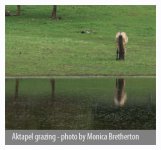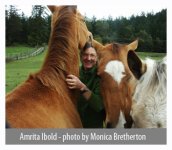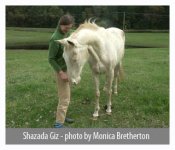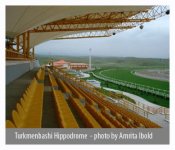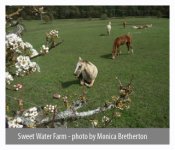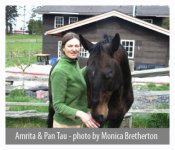♘امیرحسین♞
♘ مدیریت انجمن اسب ایران ♞
Adventures in Akhal-Teke-Land
What do Turkmenistan and the San Juan Islands have in common? They are joined by the shared passion of Amrita Ibold and Geldy Kyarizov for an ancient breed. The difference is, one of them is free to enjoy her horses and the other languishes in prison.
Amrita Ibold’s Sweet Water Farm is not hard to spot. The front pasture is studded with Akhal-Tekes, ranging from palest cremello to buckskin to coppery chestnut, colors that in the Karakum desert of their birthland might have been camouflage. Here in the Pacific Northwest they contrast vividly with the April grass.
I pause for a minute to study them. This is the breed I fell in love with as a teenager from a single picture in a horse book -- a impossibly metallic golden palomino, attenuated and angular like an El Greco painting, an ancient and exotic breed from Turkmenistan, Asia. For more information on the Akhal-Teke, you can read this May’s Breed Profile.
Because this “golden horse” is extremely rare, with a world population of fewer than 4,000, as well as ancient, with a history spanning 5,000 years, those who own and breed Akhal-Tekes take their custodial role even more seriously than most horse lovers. Even as they promote the horses in the modern sports of eventing, endurance riding, show jumping and dressage, they collect authentic tack and costumes, Some feel another call, to help the man who preserved the breed in its homeland, and promoted it to the world, even as he suffers imprisonment on trumped-up charges in a Turkmenistan prison.
His name is Geldy Kyarizov His crime was to be too successful at his task.
But first I have to meet the horses… What is so special about this desert breed that it inspires such passion in its admirers? As we duck under an opening in the hand-built wooden fence, we are enveloped by curious, eager fillies: Kichi Gul, Ayal Pikira, Shirin Giz and Ovazli Gul.
As they vie for attention, they are still careful and delicate in their movements. They roll their white-rimmed, almond-shaped eyes towards me, as I fumble with the camera, then swirl around Amrita like a pod of dolphins around a swimmer. Yet they are most definitely horses, leaning into her hands scratching their winter woolies with evident delight. Nothing unusual, really, until you notice the high carriage of the head, the hooded, swiveling eyes, and the narrow, almost tubular bodies on long legs, all adaptations of a desert dweller honed to a fine edge. The ancient Akhal-Teke must stay cool, spot predators at a great distance and run like a gazelle (there are leopards and reputedly tigers still ranging in the Kopetdag mountains of Turkmenistan).
The youngsters scatter when a gray mare drifts up to join us -- Olimpic Gul, the dominant mare in the pasture, Olga for short. As she caresses Olga, Amrita explains how it is that she fell in love with this exotic breed. Her journey also started with a picture in book.
As a girl, forced to move from a horse-rich life in Holland to a barren urban house in France, she locked herself in her room in protest. There, in her books, she stared at the picture of the striking angular horse. The Akhal-Teke had served the nomadic Teke raiders as lighting-fast transportation and daily companion. Fast, hardy and capable of remarkable endurance, these horses were known to bond closely with their riders. What better steed to carry a young woman out of a self-imposed suburban imprisonment?
Ultimately Amrita emerged from her room and rode any horse she could find. But she certainly did not travel a straight line to caring for her herd of Akhal-Tekes at Sweet Water Farm.
An under-motivated student who preferred to spend her time riding, Amrita left the Swiss boarding school chosen by her parents and went to Indonesia with a boyfriend. “I wanted to walk around, I wanted to meet the people.” This quest led to Nepal, where she took that idea to extremes - trekking alone in the Himalayas, living on radishes and rice, she nearly died of hypothermia before being rescued from a high mountain pass by a local farmer. Later, she was stranded for 5 days without gas in the Great Australian desert until strangers rescued her. Then there was the time at a farm in Ireland, employed as a caretaker, only the promised payment never arrived and she learned to eat barnacles. Survival skills of a different kind were required in Florida, where she had to convince someone to give her an apartment when she had no money and no job. Once she had a job, she bought a motorcycle and headed west.
Amrita tells the story of her life as a kind of unfolding flower, each petal curling back to reveal the next tale with its interwoven theme of connection and disjuncture. Even now, years later, living on a farm, married with a son, the sense of a journey continues as we tour through the new house she and her husband are building beam by beam, hewn from island wood at the farm’s own mill. The tiles that will surround the wood-burning stove are Turkish, though bought on E-Bay, where she also found some of the special tack and trappings that fill her “Akhal-Teke Museum.”
Many things, however, like the bottle of vodka with the President’s picture (an odd souvenir from a Muslim country), the traditional neck bands for the horses and the Turkoman tack were brought back from a trip she made in 2001, a trip that connected her directly with the man in the Turkmenistan prison.
At that time Geldy Kyarizov was at the height of his career, about to realize his lifelong dream of bringing the Akhal-Teke studbook back to Turkmenistan, complete with a new lab capable of DNA testing to verify pedigrees that in many cases were largely oral tradition. Control of the Akhal-Teke stud book had long been ceded to Russia, but as numbers grew in their homeland, in large part as a result of Geldy Kyarizov’s efforts, he made such a convincing case for the breed as a national symbol that President-for-Life Saparmurat Niazov agreed to underwrite a project that would lead to Turkmenistan's ownership of the studbook.
To understand why the Akhal-Teke breed has so many who claim to be its savior requires at least a cursory understanding of the region's history. Turkmenistan was annexed by Russia in 1881 as part of its power struggle with the British for control of the regions between India and Russia. It then became part of the Soviet Union, and through in 1991 it was officially “liberated,” in fact its new President merely consolidated the power he had held as a Soviet appartchik into a dictatorship and personality cult that rivaled that of his idol Stalin. The oil and natural gas reserves of Turkmenistan and its border on the Caspian Sea were valuable trading tokens in the international market, as was the potential oil pipeline to be built through the country,so the bizarre behavior of Niazov was shrugged off in large part by business and political figures in the Western world. The press focused on the seemingly ludicrous gestures, like the publication of his doctrine in a book called the Ruhanama, a text that attempted to create a sense of nationalist pride in a country stitched together from different tribal fabrics. He added a portrait of the stallion given to him by Geldy Kyarizov to the national seal, and spoke of the Akhal-Teke as a national treasure, second of course to himself, the great Turkmenbashi, whose image appeared everywhere.
Niazov also took great pains to put a modern face on his capital city in the form of vast structures, monuments and wide avenues reminiscent of the plans for Berlin Adolf Hitler’s architect Albert Speer. For visitors, entering the totalitarian regime could be unnerving. “They took our passports when we arrived.” Amrita says. Among the delegations was Tony Watkins, who was there to set up a clinic at the new hippodrome that Geldy Kyarizov, in his offical position of Horse Minister, or Atlary, since 1998, had succeeded in convincing the President to build. He was due to return in three days, and so was surprised to learn his passport would be held for a week. There was no argument possible. If you came to Turkmenistan, you would do as you were told.
Not that that was so bad. The week was filled with horse-related activities, which Amrita describes in the detail in an article she wrote about the trip.
The hot topic amongst the breeders, and one that Amrita and the other Americans and Europeans were anxious to debate with Geldy, was artificial insemination. In a country about the size of California, with little in the way of human medical care and even less for horses, the idea of artificial insemination was, as Amrita put it, “like witchery to them.”
Only after a sleepless night, much soul-searching, and a long discussion with his wife Yulia Serebryannik, a doctor, did Geldy return with the acknowledgement that as President of MAAK, the official organization of the Akhal-Teke breed, he would agree to change the official policy. That would be a blow to those who had a vested interest in the thriving stallion export business from Russia, but would better insure the improvement of the breed.
As was characteristic, Geldy Kyarizov put the future of the horses first. If there was one thing he wanted, it was international prominence for the Akhal-Teke. He had worked to save the remnants of the breed in its homeland from slaughter and neglect, and now it stood proudly on the national seal. However restrictive and authoritarian the regime he must live under, he had worked within the system to achieve his dream since his youth in Communist-controlled Turkmenistan.
Now the international community recognized him as an authority on the Akhal-Teke and his horses as some of the finest in the world, and his own country awarded him medals for his achievements. The hippodrome and its model lab would provide DNA testing to validate the pedigrees, artificial insemination would allow isolated breeders to continue striving for the best bloodlines, and the Akhal-Teke would reign supreme again.
Amrita Ibold’s Sweet Water Farm is not hard to spot. The front pasture is studded with Akhal-Tekes, ranging from palest cremello to buckskin to coppery chestnut, colors that in the Karakum desert of their birthland might have been camouflage. Here in the Pacific Northwest they contrast vividly with the April grass.
I pause for a minute to study them. This is the breed I fell in love with as a teenager from a single picture in a horse book -- a impossibly metallic golden palomino, attenuated and angular like an El Greco painting, an ancient and exotic breed from Turkmenistan, Asia. For more information on the Akhal-Teke, you can read this May’s Breed Profile.
Because this “golden horse” is extremely rare, with a world population of fewer than 4,000, as well as ancient, with a history spanning 5,000 years, those who own and breed Akhal-Tekes take their custodial role even more seriously than most horse lovers. Even as they promote the horses in the modern sports of eventing, endurance riding, show jumping and dressage, they collect authentic tack and costumes, Some feel another call, to help the man who preserved the breed in its homeland, and promoted it to the world, even as he suffers imprisonment on trumped-up charges in a Turkmenistan prison.
His name is Geldy Kyarizov His crime was to be too successful at his task.
But first I have to meet the horses… What is so special about this desert breed that it inspires such passion in its admirers? As we duck under an opening in the hand-built wooden fence, we are enveloped by curious, eager fillies: Kichi Gul, Ayal Pikira, Shirin Giz and Ovazli Gul.
As they vie for attention, they are still careful and delicate in their movements. They roll their white-rimmed, almond-shaped eyes towards me, as I fumble with the camera, then swirl around Amrita like a pod of dolphins around a swimmer. Yet they are most definitely horses, leaning into her hands scratching their winter woolies with evident delight. Nothing unusual, really, until you notice the high carriage of the head, the hooded, swiveling eyes, and the narrow, almost tubular bodies on long legs, all adaptations of a desert dweller honed to a fine edge. The ancient Akhal-Teke must stay cool, spot predators at a great distance and run like a gazelle (there are leopards and reputedly tigers still ranging in the Kopetdag mountains of Turkmenistan).
The youngsters scatter when a gray mare drifts up to join us -- Olimpic Gul, the dominant mare in the pasture, Olga for short. As she caresses Olga, Amrita explains how it is that she fell in love with this exotic breed. Her journey also started with a picture in book.
As a girl, forced to move from a horse-rich life in Holland to a barren urban house in France, she locked herself in her room in protest. There, in her books, she stared at the picture of the striking angular horse. The Akhal-Teke had served the nomadic Teke raiders as lighting-fast transportation and daily companion. Fast, hardy and capable of remarkable endurance, these horses were known to bond closely with their riders. What better steed to carry a young woman out of a self-imposed suburban imprisonment?
Ultimately Amrita emerged from her room and rode any horse she could find. But she certainly did not travel a straight line to caring for her herd of Akhal-Tekes at Sweet Water Farm.
An under-motivated student who preferred to spend her time riding, Amrita left the Swiss boarding school chosen by her parents and went to Indonesia with a boyfriend. “I wanted to walk around, I wanted to meet the people.” This quest led to Nepal, where she took that idea to extremes - trekking alone in the Himalayas, living on radishes and rice, she nearly died of hypothermia before being rescued from a high mountain pass by a local farmer. Later, she was stranded for 5 days without gas in the Great Australian desert until strangers rescued her. Then there was the time at a farm in Ireland, employed as a caretaker, only the promised payment never arrived and she learned to eat barnacles. Survival skills of a different kind were required in Florida, where she had to convince someone to give her an apartment when she had no money and no job. Once she had a job, she bought a motorcycle and headed west.
Amrita tells the story of her life as a kind of unfolding flower, each petal curling back to reveal the next tale with its interwoven theme of connection and disjuncture. Even now, years later, living on a farm, married with a son, the sense of a journey continues as we tour through the new house she and her husband are building beam by beam, hewn from island wood at the farm’s own mill. The tiles that will surround the wood-burning stove are Turkish, though bought on E-Bay, where she also found some of the special tack and trappings that fill her “Akhal-Teke Museum.”
Many things, however, like the bottle of vodka with the President’s picture (an odd souvenir from a Muslim country), the traditional neck bands for the horses and the Turkoman tack were brought back from a trip she made in 2001, a trip that connected her directly with the man in the Turkmenistan prison.
At that time Geldy Kyarizov was at the height of his career, about to realize his lifelong dream of bringing the Akhal-Teke studbook back to Turkmenistan, complete with a new lab capable of DNA testing to verify pedigrees that in many cases were largely oral tradition. Control of the Akhal-Teke stud book had long been ceded to Russia, but as numbers grew in their homeland, in large part as a result of Geldy Kyarizov’s efforts, he made such a convincing case for the breed as a national symbol that President-for-Life Saparmurat Niazov agreed to underwrite a project that would lead to Turkmenistan's ownership of the studbook.
To understand why the Akhal-Teke breed has so many who claim to be its savior requires at least a cursory understanding of the region's history. Turkmenistan was annexed by Russia in 1881 as part of its power struggle with the British for control of the regions between India and Russia. It then became part of the Soviet Union, and through in 1991 it was officially “liberated,” in fact its new President merely consolidated the power he had held as a Soviet appartchik into a dictatorship and personality cult that rivaled that of his idol Stalin. The oil and natural gas reserves of Turkmenistan and its border on the Caspian Sea were valuable trading tokens in the international market, as was the potential oil pipeline to be built through the country,so the bizarre behavior of Niazov was shrugged off in large part by business and political figures in the Western world. The press focused on the seemingly ludicrous gestures, like the publication of his doctrine in a book called the Ruhanama, a text that attempted to create a sense of nationalist pride in a country stitched together from different tribal fabrics. He added a portrait of the stallion given to him by Geldy Kyarizov to the national seal, and spoke of the Akhal-Teke as a national treasure, second of course to himself, the great Turkmenbashi, whose image appeared everywhere.
Niazov also took great pains to put a modern face on his capital city in the form of vast structures, monuments and wide avenues reminiscent of the plans for Berlin Adolf Hitler’s architect Albert Speer. For visitors, entering the totalitarian regime could be unnerving. “They took our passports when we arrived.” Amrita says. Among the delegations was Tony Watkins, who was there to set up a clinic at the new hippodrome that Geldy Kyarizov, in his offical position of Horse Minister, or Atlary, since 1998, had succeeded in convincing the President to build. He was due to return in three days, and so was surprised to learn his passport would be held for a week. There was no argument possible. If you came to Turkmenistan, you would do as you were told.
Not that that was so bad. The week was filled with horse-related activities, which Amrita describes in the detail in an article she wrote about the trip.
The hot topic amongst the breeders, and one that Amrita and the other Americans and Europeans were anxious to debate with Geldy, was artificial insemination. In a country about the size of California, with little in the way of human medical care and even less for horses, the idea of artificial insemination was, as Amrita put it, “like witchery to them.”
Only after a sleepless night, much soul-searching, and a long discussion with his wife Yulia Serebryannik, a doctor, did Geldy return with the acknowledgement that as President of MAAK, the official organization of the Akhal-Teke breed, he would agree to change the official policy. That would be a blow to those who had a vested interest in the thriving stallion export business from Russia, but would better insure the improvement of the breed.
As was characteristic, Geldy Kyarizov put the future of the horses first. If there was one thing he wanted, it was international prominence for the Akhal-Teke. He had worked to save the remnants of the breed in its homeland from slaughter and neglect, and now it stood proudly on the national seal. However restrictive and authoritarian the regime he must live under, he had worked within the system to achieve his dream since his youth in Communist-controlled Turkmenistan.
Now the international community recognized him as an authority on the Akhal-Teke and his horses as some of the finest in the world, and his own country awarded him medals for his achievements. The hippodrome and its model lab would provide DNA testing to validate the pedigrees, artificial insemination would allow isolated breeders to continue striving for the best bloodlines, and the Akhal-Teke would reign supreme again.

